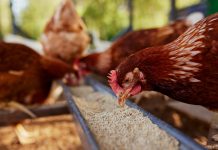Andrivon Didier, Research Director at INRAE, France’s new National Research Institute for Agriculture, Food and Environment, discusses the need for sustainable late blight control despite the threat of new evolving invaders
The famous Hervey Allen quote, ‘Each new generation is a fresh invasion of savages’, applies perfectly to the dazzling changes that shake European populations of Phytophthora infestans, the oomycete pathogen causing potato and tomato late blight (LB).
Over the past few years, we have indeed seen major upheavals in the genetic composition of these populations (Andrivon et al., 2018):
- Two new clones, EU_36_A2 and EU_37_A2, swiftly emerged and spread across western Europe since 2016/2017. These are characterised either by high aggressiveness on potato tubers (EU_36_A2), which may favour persistence in the environment and possibly spread by infected tubers, or by a significant insensitivity to fluazinam, one of the main active ingredients used for late blight control (EU_37_A2).
- A third clone, EU_41_A2, rose in Nordic populations of the pathogen. This is even more remarkable that these populations are characterised by a large diversity, due to a strong contribution of sexual inoculum to the first disease outbreaks. This high diversity was expected to make Nordic populations more difficult to invade by clonal genotypes.
The spread of these three new invaders occurs at high speed, and in unexpected directions: south and westwards for EU_36_A2 and EU_37_A2, north and eastwards for EU_41_A2 (figure 1). Such divergent patterns, and with further genotypes lurking for emergence (EU_43_A2 being one of the current candidates to the ‘next wonder’ title), make inferences about future evolutions all the more difficult to make.
Why does all this matter for sustainable LB control?
The constant and brutal changes in P. infestans populations generate less predictable epidemics and make more difficult both the tactical interventions (when and what to spray), but also the strategic choices (for instance, which resistant cultivars to pick, depending on local pathogen genotypes?) This favours the security of routine spraying schedules ahead of infection risk periods with broad-spectrum, preventative active ingredients, that allow good coverage of infection events and a reduced hazard to the crops, but at the expense of efforts to reduce pesticide application to the strict minimum (Andrivon, 2018).
This genetic instability of P. infestans population structures is further enhanced by the current climatic instability correlative of global warming and climate change. Late blight is a disease strongly dependent on local weather and microclimate, which fluctuate very rapidly and in unpredictable directions at short notice.
What to do then?
Continuous, wide-range monitoring of European P. infestans populations is the first line of action. It has been undertaken for several years now through the EuroBlight network, which carries over annual genetic surveys from late blight samples. The resulting information is made publicly available through the EuroBlight website as maps, graphs and short articles, and can thus be readily exploited by all actors in the potato industry. It is this survey which allowed to spot the emergence of the three new genotypes mentioned in this paper, and of several others, during the past decade. It therefore provides an ‘early warning’ system that is used to rapidly adjust control recommendations. For instance, fluazinam used sharply decreased over the past few years in all areas with a high frequency of EU_37_A2, as growers were warned that this active ingredient had a reduced efficacy on this genetic group of isolates.

EU_37_A2 (dark green) and EU_41_A2 (rusty brown) in Europe, 2015-2019. Data source: EuroBlight network – euroblight.net
Phenotyping emerging genotypes is the second critical step. The EuroBlight survey is based on genetic markers called microsatellites, which describe the genetic diversity within the populations but do not specifically target genes involved in pathogenicity, fungicide sensitivity, fitness or other functional traits. Therefore, these genetic data need to be supplemented by biotests to ascertain if, and how much, genotypes predict phenotypes. This was one of the major goals of the IPMBlight 2.0 project (see link below), which showed that phenotypic variation existed both between, but also within pathogen lineages. Therefore, periodic checks of phenotypic characteristics must be undertaken on already known lineages, but also on emerging ones. This is a laborious and time-consuming task, that, like the genotypic surveys, can only be carried out within funded research projects. Unfortunately, securing the funds to sustainably run these surveillance activities and maintain the EuroBlight Information infrastructure has proven difficult recently. Integrating population information into decision-making schemes is the final, and so far, widely missing link. Current DSSs are not calibrated to incorporate such information and adjust recommendations accordingly. Therefore, population compositions are now often neglected or marginally exploited by advisors, for want of timely, updated, and complete understanding of their consequences.
In the face of rapidly changing features of P. infestans populations, in Europe but also elsewhere in the world, and of the need to sustainably exploit and optimise all control options available (prophylactic measures, host resistance, biocontrol, chemical control) epidemiovigilance will be the key. Supporting and maintaining the epidemiosurveillance network and infrastructures set up by EuroBlight should thus be a top priority for research, but also and foremost for growers, buyers, consumers, and policy-makers.
References
Andrivon D (2018). The re-emergence of potato late blight: a major reason for pesticide use in arable crops. Open Access Government. (https://www.openaccessgovernment.org/pesticide-use-in-arable-crops/55271/)
Andrivon D, Hansen J.G., Anderssson B., Cooke DEL (2018). New, emerging clones of Phytophthora infestans in Europe- what do we know about them? (https://agro.au.dk/forskning/internationale-platforme/euroblight/currently/news/nyhed/artikel/new-emerging-clones-of-phytophthora-infestans-in-europe/)
EuroBlight website (https://agro.au.dk/forskning/internationale-platforme/euroblight/)
IPMBlight 2.0 project (https://agro.au.dk/forskning/internationale-platforme/euroblight/research-projects/ipmblight20/)
Please note: This is a commercial profile











